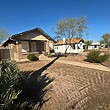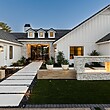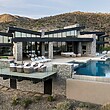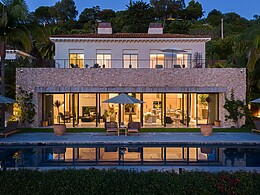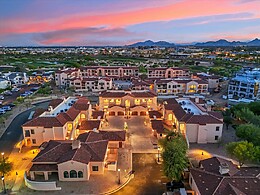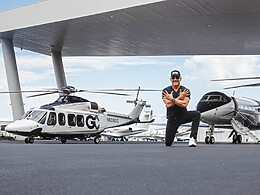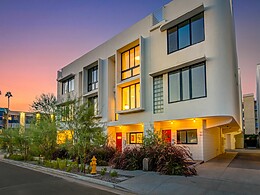
On the heels of introducing its second building phase, SOHO Scottsdale, North Scottsdale’s first live-work community, continues to foster a diverse community of resident-entrepreneurs.
Due to the community’s unique dual zoning feature, residents of SOHO Scottsdale are able to work on site, which allows client access whenever needed for a true live-work lifestyle.
Astrophotographer Ken Naiff and his wife, June, of Dark Sky Images are SOHO Scottsdale residents who are both enjoying and optimizing this community perk. As SOHO’s artist in residence, the couple’s bright loft doubles as a gallery space that showcases Ken’s awe-inspiring deep space photography.
We caught up with Ken and June to learn more about the art of astrophotography and why they believe SOHO Scottsdale is an ideal place to live and work.

AFM: Please tell us about Dark Sky Images and the art of astrophotography.
Ken: It was one clear night, a rarity in England, in October 1957 that the Sputnik satellite circled the Earth, and I viewed it through my small telescope as it orbited overhead. This was the beginning of the “space race”, and also the onset of my passion for space and astronomy.
In 1976, I emigrated to the United States from England, and enjoyed a successful 26-year technical career in electronic engineering and digital systems, being awarded 7 U.S. patents along the way, and leading the engineering effort to convert analog cable television systems to digital systems. My love for astronomy was sidelined until in 2004.
After retiring, my wife, June, and I relocated from Delaware to Arizona. I was no longer an “armchair” astronomer – I had arrived in the land of open desert spaces far from cities, and majestic clear night skies! It was perfect for astrophotography, and I grasped this opportunity to put my passion into practice.
My learning curve was steep and comprehensive, focusing on all aspects of astrophotography, networking with other astronomers, attending workshops, learning new software and astronomical hardware, honing my photography skills, as well as experimenting with different methods to image in the field, and refining post-processing techniques.
In 2014, my self-imposed apprenticeship was over, and my first images were ready for public display.
Regarding the “art” of astrophotography, it can take an entire year of field trips to get one or two finished images.
Successful field trips to the desert are impacted by a number of factors, both environmental and man-made. Light pollution is prevalent, deep space objects are dim, dark, and distant, the earth is rotating, and the ideal imaging weather is unpredictable. I have techniques and equipment to help manage distance, dimness, and rotation, but the weather can’t be controlled, and it often totally derails the best planned outing. Even a few passing clouds can adversely impact an evening’s work.
To escape the nightly light dome of nearby Phoenix, I travel up to 300 miles to dark sites during the New Moon to set up my equipment and camp for week or so several times each year.

Most of the objects I image are in our galaxy, the Milky Way. These comprise mostly nebulae, which are large clouds of dust and gas, light years across, and which may eventually collapse to form stars and star clusters.
Interestingly, deep space objects are exceptionally large, so high magnification is not a requirement for my telescopes, which serve as the lenses of my specialized cameras. Some objects are so large that I image sections of the object separately, and subsequently combine them, during post-processing, in a mosaic to form a single, seamless image.
However, these objects are also very dim and distant. In order to capture enough light from these faint objects, many long exposures are required, and each exposure may be 15 to 20 minutes long. My most recent release “Spacescape”, a large 9-frame mosaic, has 82 hours of total exposure time!
During these long exposures, the camera and telescope track precisely, typically to sub-pixel accuracy, in order to compensate for the Earth’s rotation, otherwise stars become elongated and fuzzy and the image is blurred.
Space has amazing and colorful objects. Since our brain immediately processes light, the human eye cannot capture enough light to discern the color. My cameras are monochromatic, so the images produced are black and white (grayscale). However, by inserting color filters I can capture the color and intensity of the object.
As I begin processing the data, I have many opportunities to make personal artistic choices as I refine the many “noisy” grayscale images into a single scientifically accurate, full color, high resolution, richly detailed image.

AFM: What can people expect to see when they visit the residence-gallery at SOHO Scottsdale?
Ken: “Nebulae” are my favorite deep space objects to image. They form spectacular shapes, some reminiscent of familiar objects, and all of them are awe-inspiring artistic renditions of nature.
I have imaged about 12 different nebulae, all located in the Milky Way. I have also imaged several galaxies including Andromeda, our nearest neighbor, which is 2.3 million light years away and will collide with the Milky Way in about 4 billion years!
All of my images are on display in SOHO Scottsdale’s lobbies. Additionally, several images are also on display at our residence.
We think this is a great way for people to experience art. In a casual, relaxed atmosphere, they can assess how the images look in a variety of different lights, how they group together to create a spectacular statement, and assess how the images will enhance their space.
AFM: Could you please share an example of one of your favorite images you’ve captured & the story behind it?
Ken: The decision of what to image is based on several factors: what’s available in the night sky, the technical complexities of the “shoot” and the post-processing, and, most importantly, what will be of interest to the casual buyer, decorators, and collectors.
The Horsehead and Flame Nebulae was one of my favorites to image and it’s one of the most popular and recognizable. Charging through the night sky, the iconic Horsehead is a dark molecular gas and dust cloud backlit by a nearby massive star. These nebulae generate a visual energy that is powerful and consuming.

AFM: How do you find the live-work community at SOHO Scottsdale?
Ken: In a word …perfect! We love the location, the architecture, and the residential space. The mountain views from our balcony are breath-taking and we are minutes away from all the North Scottsdale amenities and restaurants.
Of course, being able to live where we work was a real bonus. We love the idea of being able to take guests through the space in a relaxed, casual way.
Soho Scottsdale is an ever-evolving community. The Soho Fitness Center, F.R.O.G.S. Physical Therapy and the soon to open S&V Urban Italian restaurant are convenient and contribute to the social interaction within the community. And, of course, we are looking forward to Soho Scottsdale Phase II and welcoming new residents.
AFM: Please feel free to add anything else.
Ken: When people see my images for the first time, they are surprised that my images are captured from the ground rather than from space, and that space has such amazing and colorful objects!
I hope my images capture the energy, intensity and power of the night sky and will provoke questions, especially from children, so they may gain some insight into awe-inspiring objects in the star-studded Milky Way and beyond.

Click here to learn more about Dark Sky Images. For more information on SOHO Scottsdale, click here.


